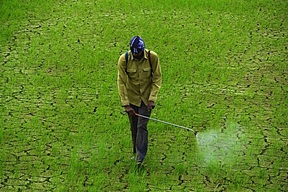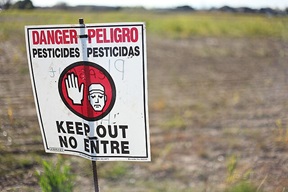Recently, Synbiobeta ran an interesting article on vaccinating plants. A new approach to activate the plant’s natural immune system. Could this lead to healthier food and more sustainable farming?

Stimulating the plant’s resistance
We have become accustomed to fighting plant diseases with pesticides. These have facilitated the major growth in food production that has fed the world since World War II. But pesticides have their downsides, and their limitations. They harm human health, damage wildlife, and promote the growth of pests not vulnerable to our common pesticide. It leads to a never-ending arms race – that we may even be losing. But vaccinating plants, making use of their natural defenses, could be an entirely new strategy, that would solve at least part of these problems.
This is precisely what a group of scientists writing in Frontiers in Science have suggested. They stimulate a plant’s resistance to prepare it for future attacks. Vaccinating plants is a new approach to crop protection, says professor Brigitte Mauch-Mani from the University of Neuchâtel. ‘We argue in favor of a holistic approach to crop protection, combining multiple strategies, with induced resistance at the core.’
The problem with pesticides
Right now, most crops are being protected with two main tools: the use of pesticides, and breeding plants with resistance genes. Both have their shortcomings. Pesticides have many unintended consequences; and pests evolve resistance faster than we can find new chemicals. Pests also adapt if we breed new and resistant varieties. But with induced resistance, we promote what plants do naturally: defend themselves. For instance, some plants release compounds that attract predators of the pests that attack them. Or plants gradually build up an immune response. The first time it is attacked, the response is mild. But a second time, the plant remembers and will go into full defensive mode.
This mechanism can be passed down to the next generation of plants. Exactly how they do this, we don’t know. But then, such an induced resistance is almost never perfect. It doesn’t lead to complete protection. And it draws on the energy of the plant – too much resistance will be to the detriment of the plant’s health.

A balancing act
But ‘safe and efficient exploitation of induced resistance,’ says Mauch-Mani, ‘is not as straightforward as the introgression of a single gene or spraying a single pesticide.’ Therefore, vaccinating plants still isn’t a magic solution. Plants need to keep a balance between growth and defense mechanisms. Too much pressure on one side will damage the other one. There is no ‘one-size-fits-all’ solution.
On the other hand, once we got this balancing act right, we could boost the nutritional quality of our food. And if we vaccinate plants correctly, this could do more than just fight off one pest – the defense mechanism might well fend off more pests as well.
New avenues
Over the past few years, a number of articles have been published supporting the idea that we can ‘vaccinate’ plants against diseases. For instance, spraying pumpkin leaves with the correct siRNA (small interfering RNA) will protect the plant against the deadly cucumber mosaic virus. Easier said than done, because we will have to establish which of the many siRNAs around will kill the virus. Still, this is much simpler and faster than genetically engineering a plant for viral resistance. Moreover, in this way scientists and farmers can keep up with the quick evolution of viral pathogens.
Another approach is to identify ways plants defend themselves in the wild. With that information, we can use modern breeding techniques and genetic engineering to strengthen the immunity of crops. It appears that plants have ‘resistance genes’ that help them to fend off infections. The problem being that plants are stuck with their genetic inheritance; whereas bacteria and fungi can evolve very quickly. The only factor helping here lies in genetic variety – a kind of library distributed across the population, containing all past infections, and strategies to combat them. The only alternative is spraying plants with some kind of poison. Or modifying our plants genetically – in order to strengthen their natural resistance.
The future
In actual practice, we are still a long way from having a good long-term solution. Most of the actual research on vaccinating plants has been done in the lab – where conditions may be quite different from those in the field. Where weather patterns, soil conditions, pest types may differ. But researching our defense mechanism in the field is absolutely necessary for rolling out a good solution. Moreover, the solution we will come up with needs to be regulated. Otherwise, farmers will not invest in it.
Even Mauch-Mani, who strongly believes that they found a powerful mechanism, makes a plea for better communication between scientists and policymakers. Otherwise, there will remain a major gap between the two worlds. Even though the new mechanism of vaccinating plants isn’t likely to be the silver bullet that will work all the time and everywhere, it still requires policy support. We need to stand by this new tool in the box – even though it needs to be complemented; for we will always need more than one approach.
Conclusion
We will have to overcome our dependency on just pesticides. They induce resistance that can develop faster than we can discover new agents. In vaccinating plants, we will have to work with nature, not against it, if we want to be heading towards a sustainable future. This new vaccinating mechanism would seem to be a step in the right direction.
Interesting? Then also read:
Pesticide resistance, a growing problem
Sustainable agriculture and weed management
Bt eggplant project in Bangladesh revisited
